Last Updated on February 4, 2021
The morning I was scheduled to go on a mine tour of Cerro Rico mountain in Potosí, Bolivia, Jess asked me ‘Why do you have to do it?’, looking at me anxiously. I knew she wasn’t happy about me going into this mountain, especially after finding out that it can collapse anytime, and spending a couple of hours crawling through narrow muddy passageways in the worst conditions thinkable, and had no interest in experiencing the mine for herself.
However, I just had to know what it was really like inside this mine. We had read so much about Cerro Rico, the fabled mountain that helped the Spanish to get rich when they conquered South America in the 16th century, providing them with enough silver to build a bridge from Potosí to Madrid (figuratively, of course). Now, the silver is long gone, and Potosí, once one of the biggest and wealthiest cities in the world, is now the poorest city in Bolivia.
Why risk my life?
Reading about the dangers of the Cerro Rico mine tours certainly didn’t leave me unaffected – possible accidents through explosions or trolleys gone lose, potential cave ins and exposure to silica dust, asbestos deposits, chemicals and gases, doesn’t sound like most people’s idea of a fun day out. But it wasn’t supposed to be fun anyway, it was supposed to be educational and eye-opening.
Miners continue to go into the mountain every day, even though there is no silver left, and the state-run enterprise closed down in the late 80s due to high losses and not enough profits. After that, the miners were desperate to keep working and formed cooperatives that, without state involvement, work for themselves and still extract enough minerals such as led, zinc and tin to make money off it. Apparently the mountain looks like a Swiss cheese on the inside now, with hundreds of tunnels running through it, which is why it is on the verge of collapse.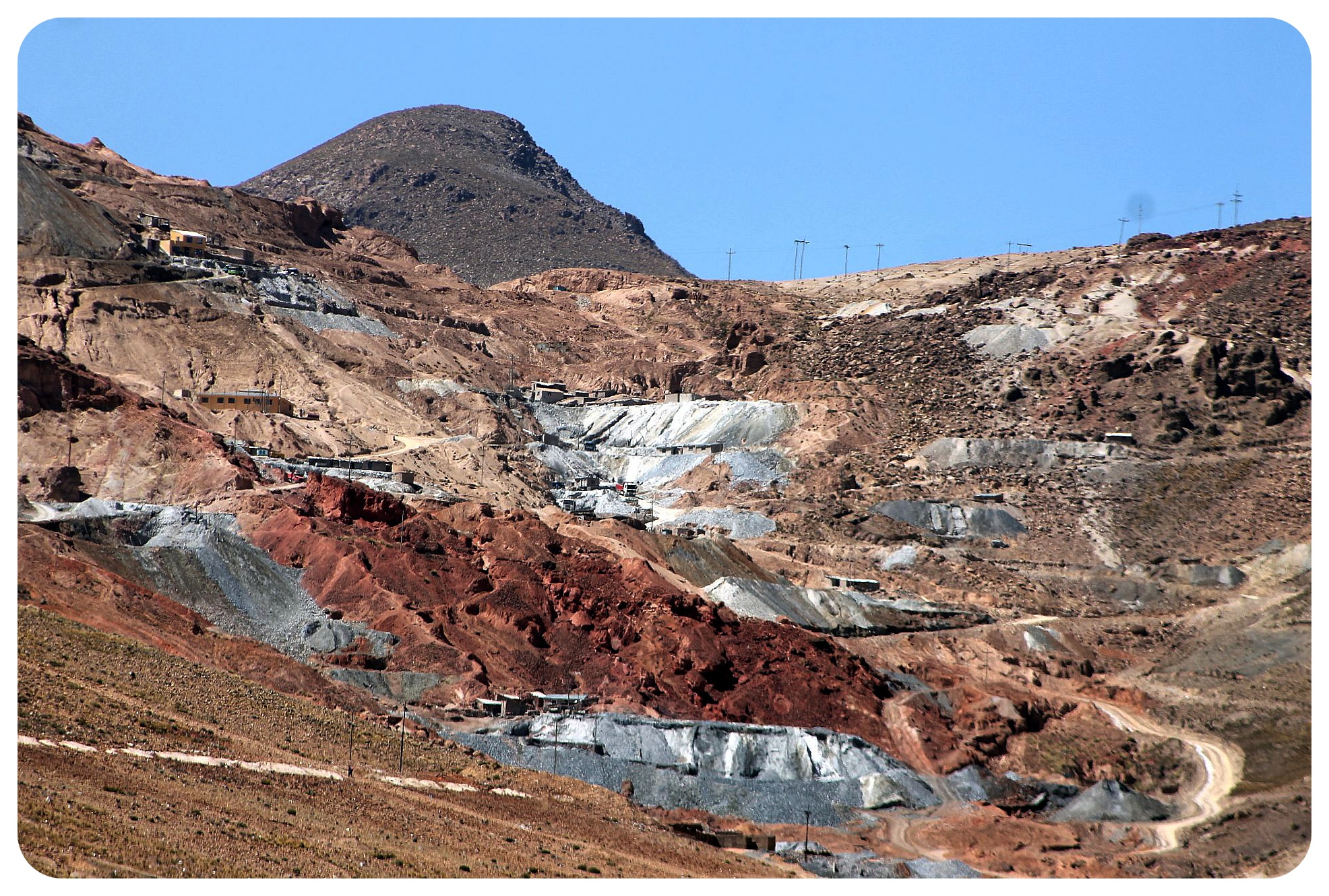
You can read all about the horrendous conditions, but it is just not the same as seeing it with your own eyes, feeling the darkness of the tunnels, lit only by your headlamp, the smells of gas, the noise, the claustrophobically narrow tunnels.
So I booked myself a spot on a Cerro Rico mine tour with GreenGo Tours, said to be one of the more responsible tour operators that don’t sensationalize the experience (until a couple of years ago, other tour companies allowed tourists to set off dynamite just for fun). It was only me, a couple from France, and our guide Julio, who made our way up to Cerro Rico on this sunny Friday morning, hoping to learn more about the mine, the miners, their lives and working conditions.

The road leading up to Cerro Rico
Cigarettes and coca leaves: gifts for the miners
There is some controversy around these tours and if it is okay to watch the miners like some kind of zoo animals but I had read that they actually appreciate the tourists since they bring them gifts and distract them from their monotonous work for a while. It is obligatory to bring the miners some presents, which is why the tour starts at the so-called miners’ market. I pictured a big market where all the stalls offer something for the miners’ needs, but in the end this ‘market’ turned out to be one of many similar little shops along the road that leads up to the mine that sell things like rubber boots, head lamps, masks, juice, cigarettes, coca leaves, dynamite and gloves.
I asked Julio what they needed the most and he suggested juice, coca leaves and cigarettes. Especially the last two might seem a bit bizarre, but since the miners all work in cooperatives they have to provide their own gear and tools, which they often can’t afford from their little salary, and snacks are a luxury which they can’t justify.
We had changed into our protective gear and helmets in a nearby storage room and hopped on the next bus up to the mine – not without getting some funny looks by fellow passengers. I felt a bit silly in my gear, very obviously not a Bolivian miner. The minute we walked into the area of Julio’s cooperative (he’s actually a member, and nobody but him can tour the tunnels of this particular co-op), the miners who were standing outside taking a break were cheering at him, offering him beer and joking around with him. It made me feel better to see that they seemed to truly like him and not just tolerate him.

Miners market shop with alcohol, cigarettes and other necessities
Before we went into the mine, he told us a lot about the miners, their struggles and their lives. ‘Don’t ask them if they like working at the mine-’, he said, ‘don’t be stupid’. Obviously nobody enjoys spending 8 – 10 hours in the closely-spaced tunnels inside a dark mountain, but most of them can’t find any other work, and the mine pays pretty well compared to other jobs in Potosí (of which there aren’t many in the first place). They get 120 Bolivianos a day, around US$17.40, which adds up to US$4,500 a year – way above the average wage of US$1,503 in Potosí. You have to consider, however, that the miners are usually the sole providers for their families and that, after nearly 500 years, the mountain does not have many minerals left, which means that the 15,000 men who are working in the mines will be out of work sooner or later.
The cooperative we visited has over 400 members and Julio assured us that there are no children working in the mines anymore, one of the things that was always a big complaint about the Cerro Rico silver mine. He told us that many of the miners don’t want their sons having to work in the mine when they are old enough and one miner told us later that when his 16-year old son failed his school year, he brought him to the mine for a month during his summer break to show him what would await him should he fail high school. The next year, his son studied like crazy and swore never to set foot in the mine again.
Inside the mine: close to a panic attack
The minute we entered the tunnel that led into the mine, I got really scared. It was darker than I had imagined – conditions inside Cerro Rico are said to be about 50 years behind modern mining technology, which means there are no lights in the tunnels for example, and the trolleys used to bring rocks and dirt out of the mine seemed to be from the 19th century. We also couldn’t walk standing up straight at all. Julio told us that we had to run for the first 300 meters because of the trolleys that use this way to exit the tunnel – and sure enough the first cart came running at us not long after entering the mine! The four of us jumped into a little nook and I was praying that the trolley wouldn’t hit us.
It passed us with only millimeters to spare and Julio was ready to move on when I thought to myself ‘I can’t do this. I have to turn around.’ I was breathing heavily, the air was so thin that I was basically wheezing. But Julio had already disappeared into the darkness of the tunnel, the French couple in toe, and so I followed them, feeling a panic come up inside of me that I’ve never experienced before. We were rushing deeper and deeper into the mountain and I remembered the article I had just read about a crater that had opened near the summit of the mountain a couple of years ago. Geologists were warning that more collapses and implosions would follow in other parts of Cerro Rico. I was so scared that I thought I was going to have an anxiety attack.
The trolleys, filled with rocks and debris that are discharged outside of the mine, weigh 700 pounds and need to be pushed by three people – and can easily get out of control because they don’t have breaks! Trolley accidents are actually among the most common accidents in the mine. When the next trolley passed us, the three young guys who pushed it asked if we had juice. I quickly took one of the 2-liter bottles that I bought out of my backpack and Julio threw it on the trolley.
Not all of the miners had time to talk, but the ones who were on a break were as interested in us as we were in them, wanting to know where we were from, if we had kids, what we did for a living. We were only at our second stop when Julio disappeared into one of the tunnels off the main passageway, and I finally started to calm down a bit. I was still extremely tense, terrified that the mountain might collapse at any time, and had a hard time breathing due to the stuffy, thick and dusty air.
Julio returned and told us that Ernesto, the miner he went to talk to, was in the middle of setting up two sticks of dynamite and we would be hearing an explosion shortly. Now I was even more scared, and so ready to leave – if I only knew which of the three completely black tunnels was the way out. Ernesto came running down the tunnel and right after he sat down with us, we heard the two explosions go off nearby, while I cowered in a corner covering my ears with my hands. No smoke cloud came out of the tunnel though (I had expected getting covered in dust), and the miner had time before going back down there to stay for a chat and to refill his bag of coca leaves from the 1 pound bag we had bought. Most of the miners we saw inside the mine had a bunch of coca leaves stuffed in his cheeks, making it look as if they had a tennis ball inside their mouths. Coca helps to reduce hunger, and keeps them awake during their long shifts in the darkness.
Ernesto’s job was simply burrowing into tiny crevices and placing dynamite. He was one of the smaller miners, which allowed him to do this job. Most of the miners specialize in one type of work: the younger ones usually fill the rocks and debris into the trolleys, others excavate, and others are in charge of making new tunnels.
The horrible working conditions in the mine
The working conditions are so obsolete that the excavators still use hammers and iron chisel to break through the rock. No oxygen is being pumped in, the rails and trolleys have never been renewed. There are no health and safety regulations in place, which is why most of the miners don’t even wear masks and thus breathe in gas and dust all day long. The minerals and raw metals that are found are brought out of the mine in shoulder bags weighing up to 80 pounds (36 kg). The conditions in the mines have been horrible since the 16th century when the Spanish conquerors used local Quechua people as slaves, forcing them to work inside the mines for days without leaving, and thousands of slaves and miners have lost their lives inside the mountain. For this reason, Bolivians call Cerro Rico La montaña que come hombres – the mountain that eats men. If the miners don’t die in a trolley accident, a cave-in or an explosion gone wrong, they are likely to die from the long-term consequences of working in the mines – usually lung diseases caused by breathing in poisonous gases on a daily basis for many years.
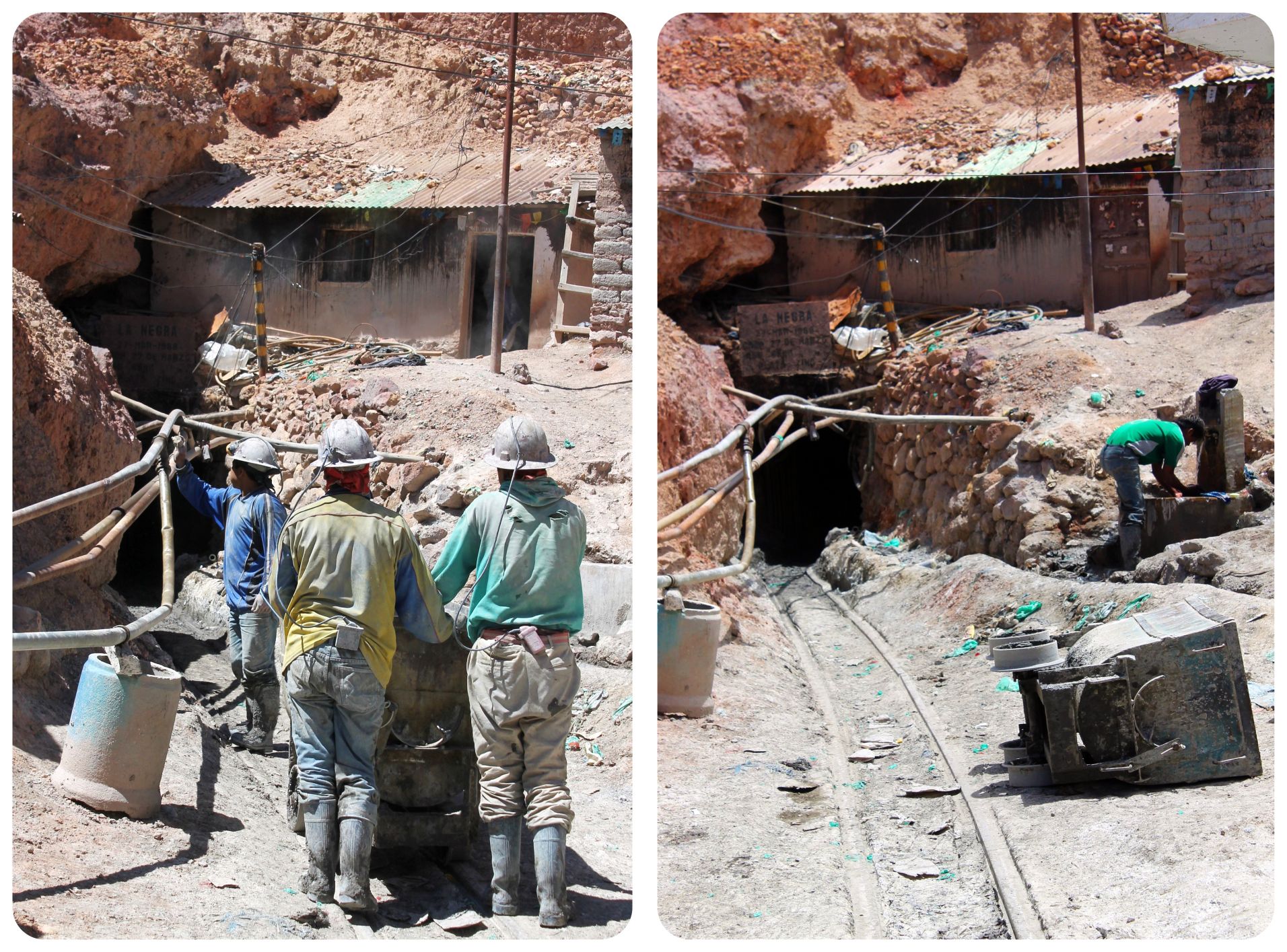 We met one last group of younger miners before we made our way back out of the mountain. They joked and laughed with Julio for a while and were curious about us. When one of them asked if we had juice, and there was no bottle left because I had already given my two bottles away, I felt guilty instantly. These guys had been in the mine since 8am and were sweating, their clothes sticking to their skin. The inside of the mountain is actually hotter than the outside, up to 40C in the deeper tunnels. I handed over the small bottle of water I had brought for myself, knowing I would be out of the mountain soon, while they still had at least 4 more hours left inside and were already dehydrated and tired.
We met one last group of younger miners before we made our way back out of the mountain. They joked and laughed with Julio for a while and were curious about us. When one of them asked if we had juice, and there was no bottle left because I had already given my two bottles away, I felt guilty instantly. These guys had been in the mine since 8am and were sweating, their clothes sticking to their skin. The inside of the mountain is actually hotter than the outside, up to 40C in the deeper tunnels. I handed over the small bottle of water I had brought for myself, knowing I would be out of the mountain soon, while they still had at least 4 more hours left inside and were already dehydrated and tired.
I was so relieved when Julio announced that it was time to leave, I almost burst into tears of joy. We hurried back out along the tracks, hoping that no trolley would come while we were on them. When the light at the end of tunnel finally came in sight, I ran faster, holding my helmet with my hands as it continued to hit the low ceiling. Outside, the bright sunlight was almost blinding, and it took me a few minutes to catch my breath and to realize that I survived Cerro Rico.
This mine visit was by no means a pleasant experience, and I have to admit that I was surprised about how much I panicked inside the mountain – I am usually not claustrophobic – and how trapped and scared I felt the entire time. Knowing that these men spend 60 or 70 hours every week inside Cerro Rico is something I can’t wrap my head around.
I am still glad that I went inside the mountain, got to meet some of the miners and saw how hard working in a mine is – especially in this one which is so far behind when it comes to modern mining techniques. It was an eye-opening experience and made me appreciate minerals like zinc and lead so much more, being aware of how hard it is to extract them.
If you visit Cerro Rico:
If you are in any way claustrophobic, this tour isn’t for you.
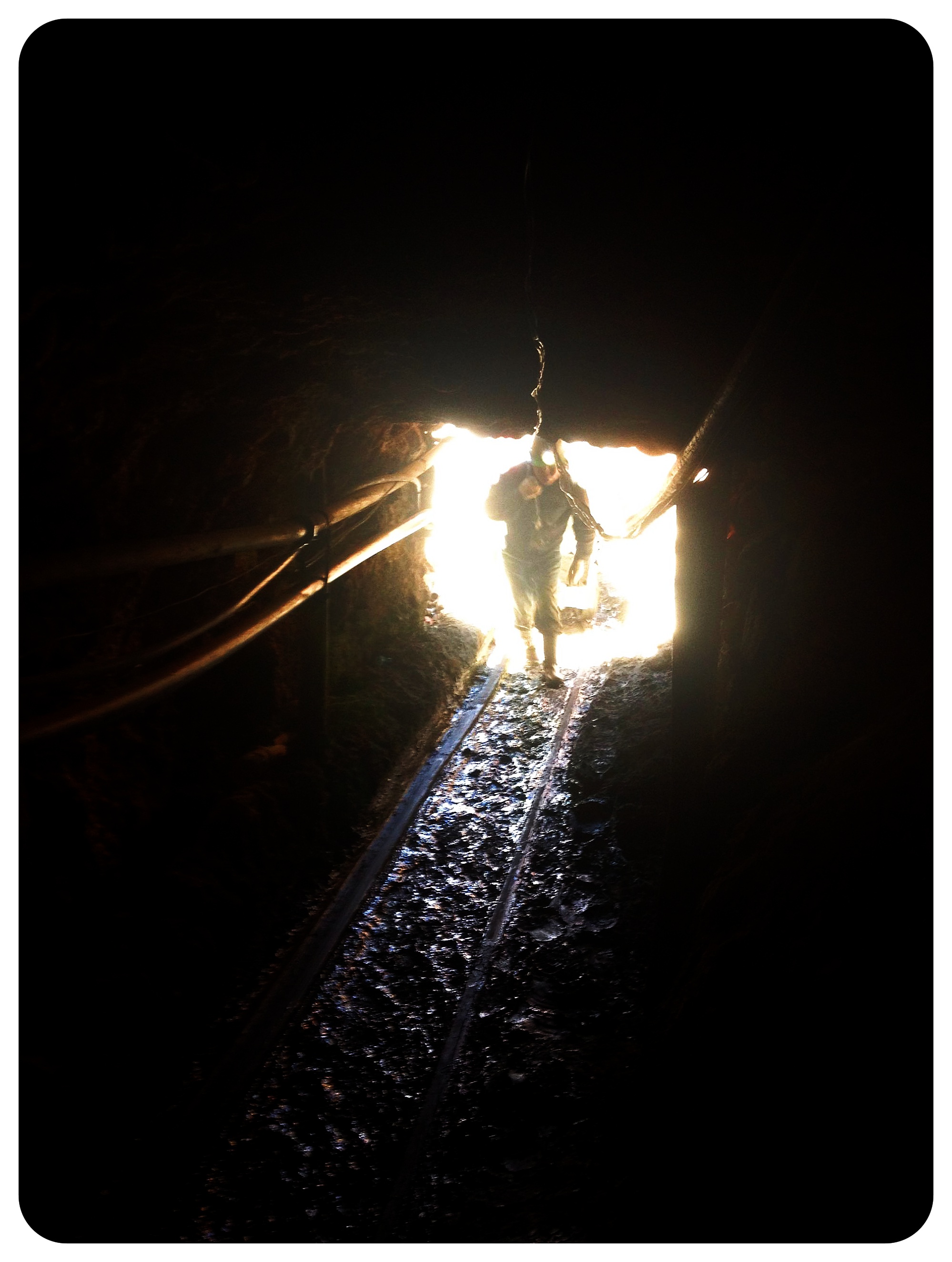 The Cerro Rico mine tour is an experience you will never forget and that will probably change your perspective on your own life. It is supposed to be an educational an informative experience, not a spectacle. Choose the company you go with carefully – I opted for Greengo Tours because it is run by an actual former miner (most companies claim their tours are run by former miners, which isn’t true in many cases) who is a member of the cooperative he shows visitors and makes sure visitors understand that this is an actual working mine, not a tourist attraction. Greengo charges BOB130; plus an additional BOB50 – 100 for you to spend on presents for the miners (it is entirely up to you how much you want to spend, but you have to bring something).
The Cerro Rico mine tour is an experience you will never forget and that will probably change your perspective on your own life. It is supposed to be an educational an informative experience, not a spectacle. Choose the company you go with carefully – I opted for Greengo Tours because it is run by an actual former miner (most companies claim their tours are run by former miners, which isn’t true in many cases) who is a member of the cooperative he shows visitors and makes sure visitors understand that this is an actual working mine, not a tourist attraction. Greengo charges BOB130; plus an additional BOB50 – 100 for you to spend on presents for the miners (it is entirely up to you how much you want to spend, but you have to bring something).
Don’t visit the mine on a Sunday – this is the one day when the mine is actually not working. However, some tour agencies still offer Sunday tours to make a profit. Buy a face mask – None of us had one, but it was so dusty inside the mine that I wished I had one.
If you bring your camera, bring a plastic bag for it, or it will be covered in dust after the tour.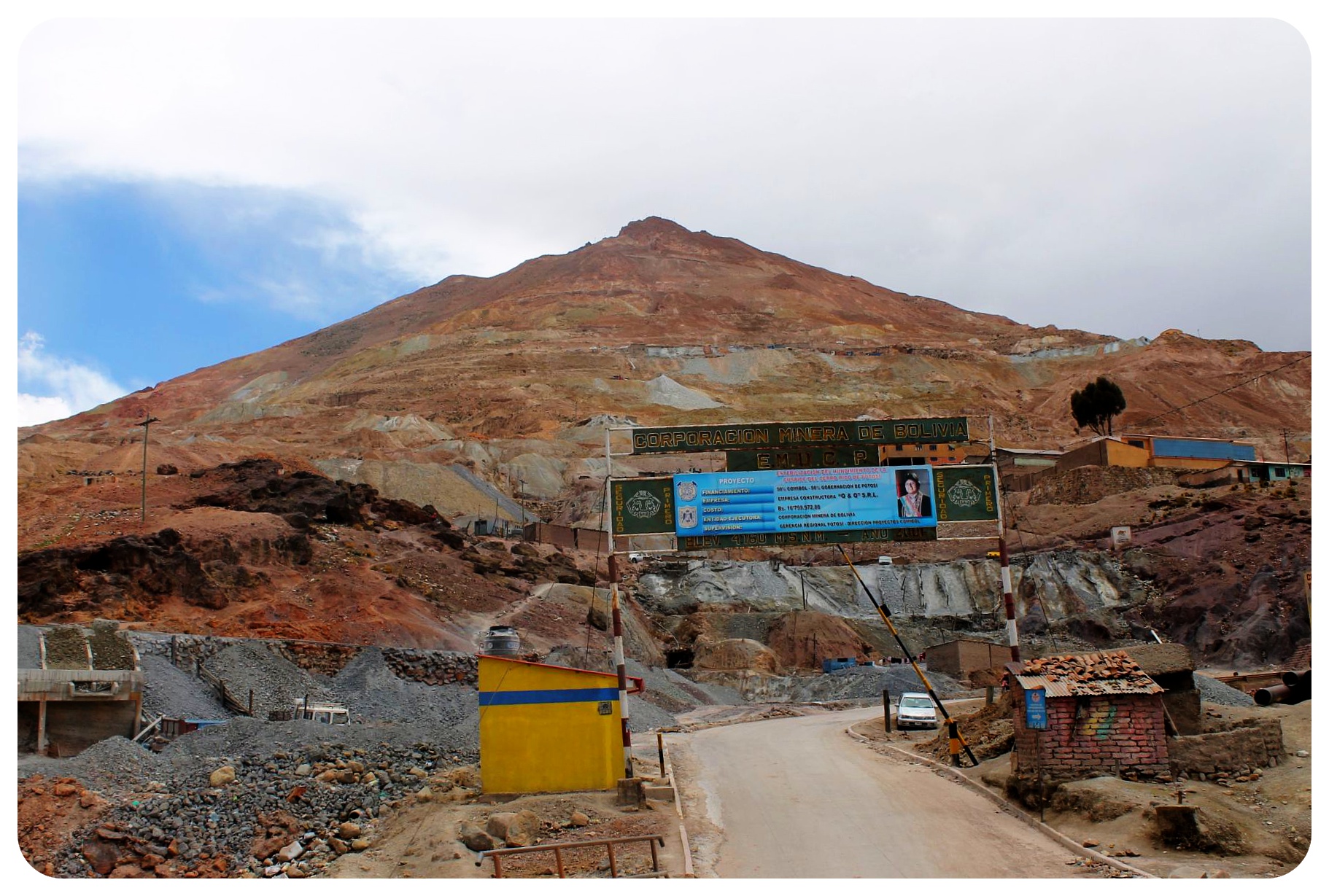
How do you feel about tours like this one – human zoo or educational? Share in the comments below!

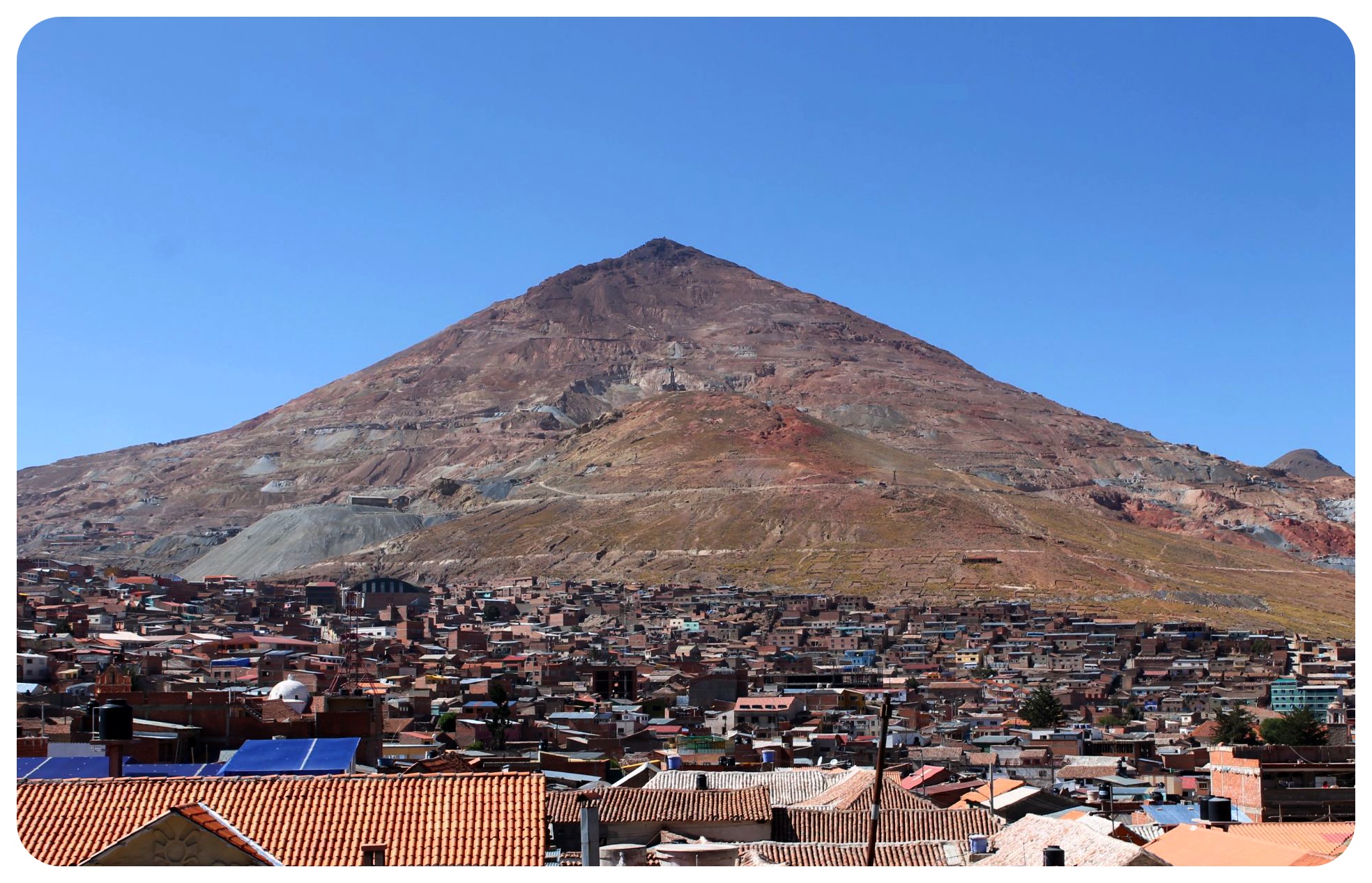



Ned
Saturday 26th of September 2015
My wife and I will be visiting Potosi next month with a tour company. We will be visiting the miners, but I am sure that the visit will be outside the mine( thank God!!). We are all senior citizens, so the tour agency would not risk us in the bowels of the mine. You are certainly courageous! Your story-telling was riveting. Thanks for being the " guinea pig" to give the rest of us a first hand picture.
Dani
Friday 2nd of October 2015
Ned - I think staying outside of the mine is a sensible idea :D It was one of the most claustrophobic experiences of my life. I hope you'll enjoy your trip - Potosi is a lovely town.
Brigid
Tuesday 29th of July 2014
Great post, felt like I was right there with you when reading it!
I also did a tour of the mine a couple of months ago with Big Deal Tours. I quite liked that the tour company is run by current and ex-miners.
It really was both an insightful and humbling experience. Though have to say, it wasn't too difficult an experience for me given I'm only 5 foot lol! Jokes aside, I can't imagine what it must be like to have to work day in, day out in those conditions.
Did you manage to see 'The Devils Miner' while you were in Sucre? Was such a powerful look into the lives of miners and the children who also work at the mines.
Dany
Thursday 31st of July 2014
Thanks so much, Brigid! I did watch The Devil's Miner in Sucre, at the Joyride Cafe :) Our guide in the mine told us though that the movie was totally staged and they just paid a random kid from Potosi $200 to play the main part. Not sure if that's true?! He said that the locals were pretty mad when the film crew came in and didn't pay any of the people in the movie a lot or gave back to the community in other ways. That left a bit of a bitter taste in my mouth...
Stevo Grubor
Tuesday 22nd of July 2014
We booked our mine tour through Koala Den for 100 bolivianos and it was an incredible experience. We felt very safe all the way through as you have 2 ex-miners as guides for the group to help you get around and also so that you can leave at any time if you wish.
We were given protective clothing, boots and a helmet and head torch before going to the miners' market to buy presents for the miners. We got to try 96% alcohol (!) and were shown the correct way to chew cocoa leaves with added sweetener. Our guides were very informative about the miners and their work. We also saw the silver being processed from the original minerals which was interesting.
We spent 2 hours down in the mines and descended 30m. It was very intense as some of the tunnels are low or narrow and the working conditions are awful. However, it was an eye opening experience that is not to be missed. Tours run in English and Spanish.
Dany
Monday 28th of July 2014
Stevo - thanks for sharing your experience!
Charli | Wanderlusters
Tuesday 25th of March 2014
I can't imagine what daily life down there must be like. I do suffer with anxiety and the thought of going down there fills me with dread. We're doing a caving tour in Waitomo New Zealand tomorrow, a super safe underground expedition, and I'm rather nervous. You're so brave Dani! Great post highlighting the history and reality of the Cerro Rico.
Dani
Wednesday 2nd of April 2014
Thanks, Charli!! I hope your caving tour did go well - I remember that we did one in Belize and it was pretty insane :D
ArianweN
Thursday 20th of March 2014
I did this tour too. I found it incredibly humbling. The workers and the guides had the best sense of humour. I vowed never to complain about my job again. That didn't last, but I still think about the Potosi miners and it has definitely broadened my perspective.
Dani
Friday 21st of March 2014
Ari - Humbling is the right way to describe this experience. It definitely changed my perspective and I also thought: I can never ever complain about my job again. Still thinking about the miners all the time!